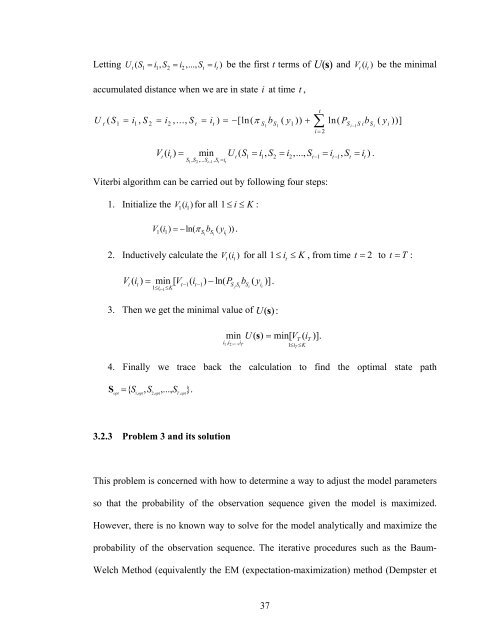multivariate poisson hidden markov models for analysis of spatial ...
multivariate poisson hidden markov models for analysis of spatial ...
multivariate poisson hidden markov models for analysis of spatial ...
Create successful ePaper yourself
Turn your PDF publications into a flip-book with our unique Google optimized e-Paper software.
Letting Ut( S1 = i1, S2 = i2,..., St = it)<br />
be the first t terms <strong>of</strong> U (s)<br />
and Vt( i<br />
t)<br />
be the minimal<br />
accumulated distance when we are in state i at time t ,<br />
U ( S = i , S = i ,..., S = i ) = − [ln( π b ( y )) +∑ ln( P b ( y ))]<br />
t 1 1 2 2 t t S1 S1 1<br />
Si−1S i Si<br />
i<br />
i = 2<br />
t<br />
V ( i ) = min U ( S = i , S = i ,..., S = i , S = i ) .<br />
t t t 1 1 2 2 t−1 t−1<br />
t t<br />
S1, S2,... St−1,<br />
St=<br />
it<br />
Viterbi algorithm can be carried out by following four steps:<br />
1. Initialize the V1( i1)<br />
<strong>for</strong> all 1 ≤ i≤<br />
K :<br />
V ( i ) =− ln( π b ( y )).<br />
1 1<br />
Si<br />
Si<br />
i1<br />
2. Inductively calculate the Vt( i<br />
t)<br />
<strong>for</strong> all 1≤ it<br />
≤ K , from time t = 2 to t = T :<br />
V ( i ) = min [ V ( i ) − ln( P b ( y )].<br />
t t 1 1<br />
1<br />
t − t −<br />
≤i<br />
S j S i S i i t<br />
t−1<br />
≤K<br />
3. Then we get the minimal value <strong>of</strong> U (s) :<br />
min U ( s ) = min[ V ( i )].<br />
i1<br />
, i2<br />
,..., iT<br />
T T<br />
1≤iT<br />
≤K<br />
4. Finally we trace back the calculation to find the optimal state path<br />
S<br />
opt<br />
= { S , S ,..., S<br />
, opt 2, opt T ,<br />
1 opt<br />
}.<br />
3.2.3 Problem 3 and its solution<br />
This problem is concerned with how to determine a way to adjust the model parameters<br />
so that the probability <strong>of</strong> the observation sequence given the model is maximized.<br />
However, there is no known way to solve <strong>for</strong> the model analytically and maximize the<br />
probability <strong>of</strong> the observation sequence. The iterative procedures such as the Baum-<br />
Welch Method (equivalently the EM (expectation-maximization) method (Dempster et<br />
37















